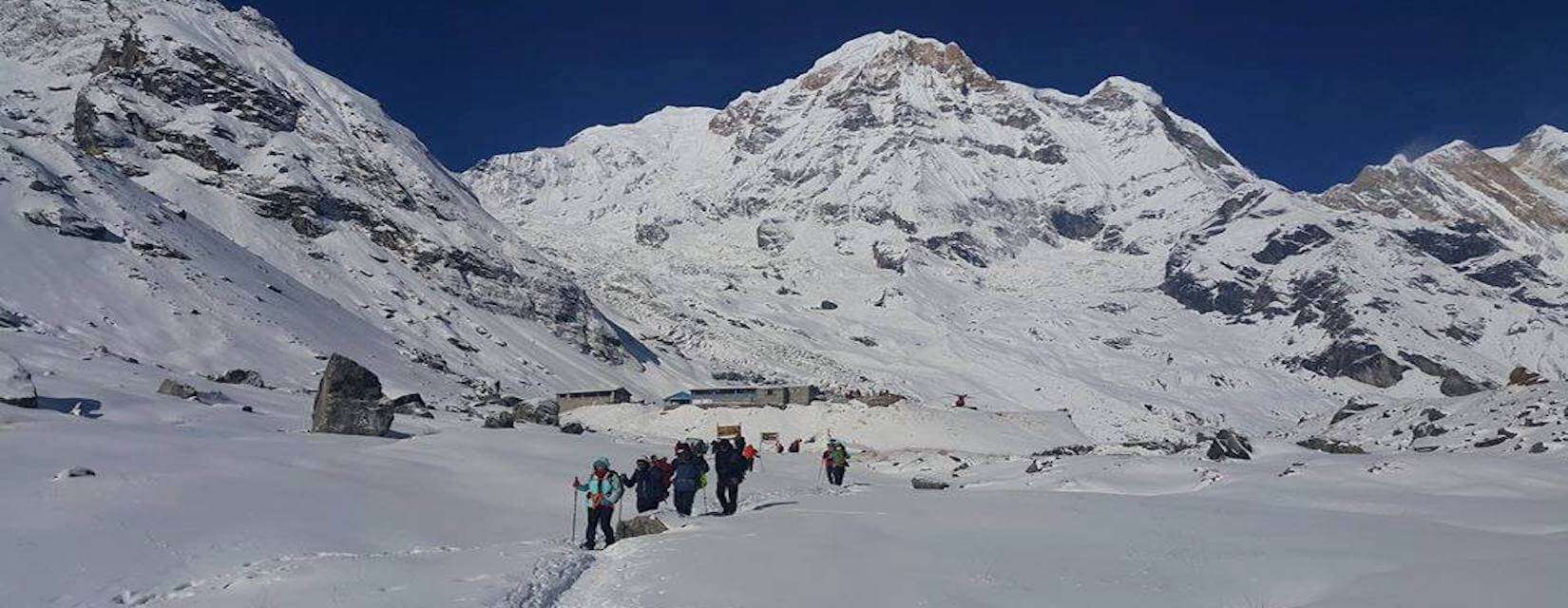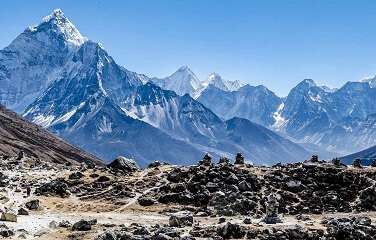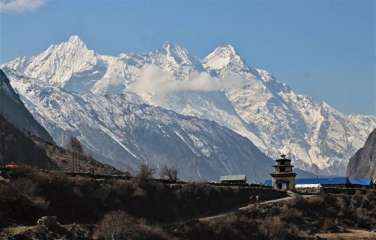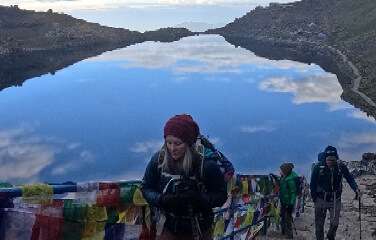Annapurna Base Camp Trek

Duration: 11 Days
Difficulty: Moderate
Group: 1 - 25 people
Max Altitude: 4,130m
Best Time: Feb - May, Sep-Dec
Pick-up: Private Vehicle
Annapurna Base Camp is one of the most well-known journeying courses in Nepal. This trip comprises of different landscapes, cultures, and wild with the most dynamite perspective on Annapurna reach, Machapuchare, and Dhaulagiri. A great stroll through rich normal ways to encounter mystical dawn through Annapurna Base Camp is the feature of this trek. The Annapurna Base Camp is a high frigid bowl lying 40 Km straightforwardly north of Pokhara, Nepal. The oval-molded level sits at a height of more than 4100 meters above ocean level. The Annapurna Sanctuary is encircled by a ring of mountains, the Annapurna range, the greater part of which are north of 7000 m above ocean level.
Annapurna Circuit Trek

Duration: 21 Days
Difficulty: Moderate
Group: 1 - 25 person
Max Altitude: 5,416m
Best Time: Feb - May, Sep-Dec
Pick-up: Private Vehicle
Need to encounter a tad of everything, as delightful scenes, minuscule mountain towns, and confoundingly high elevations? The Annapurna Circuit Trek will take you through lush gulches and over influencing engineered overpasses, into separated mountain networks, and across the renowned snow-shrouded Thorung La Pass (5416 m/17,769 ft) on a 14-day journey (with a couple of days either side in Kathmandu and Pokhara for arrangement and trip recuperation.
Ghorepani Poon Hill Trek

Duration: 10 Days
Difficulty: Easy
Group: 1 - 25 people
Max Altitude: 3,210m
Best Time: Feb - May, Sep-Dec
Pick-up: Private Vehicle
Blending heart-mixing mountain sees with charming towns and delightful timberlands with 1,000 blossoming rhododendrons, this Ghorepani Poon Hill Trek is an impressive prologue to traveling in Nepal. The feature is Poon Hill itself, an hour's stroll over the town of Ghorepani. Watching the dawn from here is a practically compulsory Nepalese experience. As the primary light emissions sparkle across a scene that incorporates Dhaulagiri I (8,167m), South Annapurna (8,091m), and Nilgiri (6,940m), it seldom disheartens.
Tilicho Lake Trek

Duration: 18 Days
Difficulty: Moderate
Group: 1 - 25 people
Max Altitude: 4,936m
Best Time: Feb - May, Sep-Dec
Pick-up: Private Vehicle
Tilicho Lake Trek isn't just with regards to the turquoise and serene Lake. As the Lake sits in a goliath cauldron, adventurers partake in the beautiful very close mountain view. Reveal the excellence of the Annapurna range with the exquisite Tilicho Lake Trek. It is a charming excursion that enriches the adventurers with dazzling perspectives on the Annapurna pinnacles and Nilgiri, Tilicho, and some more. The Lake alone takes the core of the explorers due to its curious setting. Tilicho Lake Trek has turned into a renowned objective for nature fans among the climbing trails nearby Annapurna. Tilicho Lake Trek offers tremendous and invigorating perspectives on the globe, the colossal scope of culture and variety, the most excellent profundity of the crevasse, and high pinnacles adjoining the Annapurna Himal.
Mardi Himal Trekking

Duration: 11 Days
Difficulty: Moderate
Group: 1 - 25 people
Max Altitude: 4,250m
Best Time: Feb - May, Sep-Dec
Pick-up: Private Vehicle
The Annapurna traveling district has a delightful pinnacle called Mardi Himal that stands 5,587 meters above ocean level. Furthermore, this journeying experience takes you to the headquarters of this excellent mountain to be at the rise of 4,500 meters above ocean level. The Mardi Himal Trek offers its own remarkable experience. This journey comprises an assorted scene comprising of thick backwoods, lavish green valleys, rich verdure, waterways, and goliath mountains. While being a reasonably troublesome trip it has such magnificent perspectives on the baffling Himalayas and nature making it worth a walk.
Nar Phu Valley Trek

Duration: 12 Days
Difficulty: Moderate
Group: 1 - 25 persons
Max Altitude: 5,315m
Best Time: Feb - May, Sep - Dec
Pick-up: Private Vehicle
Lesser known and least went in the Annapurna district is Nar Phu valley. The valley exists in the folds of the Annapurna mountains. Along these lines, it is a subtly covered-up and meticulously lovely traveling area. Nar Phu valley Trek includes a dry and fruitless scene than average green timberlands. Accordingly, with the tough territory, the district's social altruism is very unique also. Sorted as trying, the Nar Phu Valley trail is energizing and holds shocks up its sleeves on essentially every turn you take. It incorporates the brilliant Himalayan nature alongside the antiquated Buddhist culture. Since it has been opened for the travel industry just beginning around 2003, the valley has stayed unseen for a really long time and ends up being a secret diamond for adventurers offering them a chance to want to venture out back to entrancing stone towns underneath snow-covered Annapurnas.
Which is the best season for Annapurna region Treks
The climatic condition of Nepal differs from place to place depending upon geographical regions. One can have warm and hot wear in the terai whereas can observe the chilling arctic-like weather in the Himalayas. Nepal’s weather is influenced by a maritime and continental factor and has four different seasons, Autumn (September to November), followed by Winter (December to February), Spring (March to May), and finally, there is Summer/Monsoon (June to August).
The best time to go on an adventurous journey in the Himalayas is in Spring (March to May) and Autumn (mid-September to November). These are the best times to go on any treks and climbing trips because of stable weather and a moderate climate. There is only one place in Nepal, where you can go trekking in even monsoon (July to mid-September) and that is Upper Dolpo. This region lies in the rain shadow of the Annapurna and Dhaulagiri ranges and therefore does not receive rainfall in the monsoon.
Autumn (September To November)
Autumn (September-November) is one of the perfect seasons to trekking with hiking in Himalayan Nepal, so thousands of trekkers choose these months. In fact, September, October, and November months are will be full of excellent atmosphere as well as beauty, enjoys your journey with joy and beauty. The Autumn season provides reference weather with clear magnificent mountains. The temperature is good than another season. September-November is a great time to express your adventure in Himalayan Nepal. It will also be free from natural disasters such as floods and landslides these months. It's the most famous season to goes high altitude area of Himalayan.
Winter (November To March)
Winter (November-March) is also possible to trek in Himalayan Nepal, the weather condition is stable and the days are clear. December, January and February are the cold months in Nepal. Days temperatures are cool but the nights are much cold. During the winter trek is risk winds and colder temperatures. Above 3,000m altitude being usually snowfall and freezing. If you are looking for wonderful scenery, let choose the lower elevation trek in Nepal.
Spring (March To May)
Spring (March-May) is the second famous trekking season in Himalayan Nepal. March, April, and May is also a great option to mountain climbing and high altitude trek. At spring morning weather condition will be clear, but the afternoon sky covered by the cloud, and sometimes can be rain. You can get to see beautiful flowers like jasmine, pine, and rhododendron with wild flora. During the Spring, lower altitude trek is mildly warm and above 3,000m quite a moderate temperature. This season also best to express your adventure in Nepal.
Summer (June To August)
In the summer season, the trekkers are less crowded in the Himalayan region will be less. June, July and August are the main raining season in Nepal which involves monsoon. Bad weather can hamper travel, maybe some problems during the journey due to heavy rain. Some travelers prefer to travel at this time as this is also not an emergency period. The weather is hot and almost everyday rains. This season is better for the tour to Tibet and in Himalayan Nepal like Mustang, Dolpo region, and Nar-Phu valley because these regions are in the rain-shadow.





